 Tel/WhatsApp
Tel/WhatsApp
Modern rice milling process
Modern rice milling process is a process of removing the husk and the bran layers, and produce an edible, white rice kernel that is sufficiently milled and free of impurities.
Most rice varieties are composed of roughly 20% rice hull or husk, 11% bran layers, and 69% starchy endosperm, also referred to as the total milled rice.
In an ideal rice milling process this will result in 20% husk, 8-12% bran depending on the milling degree and 68-72% milled rice or white rice depending on the variety. Total milled rice contains whole grains or head rice, and brokens. The by-products in rice milling are rice hull, rice germ and bran layers, and fine brokens.
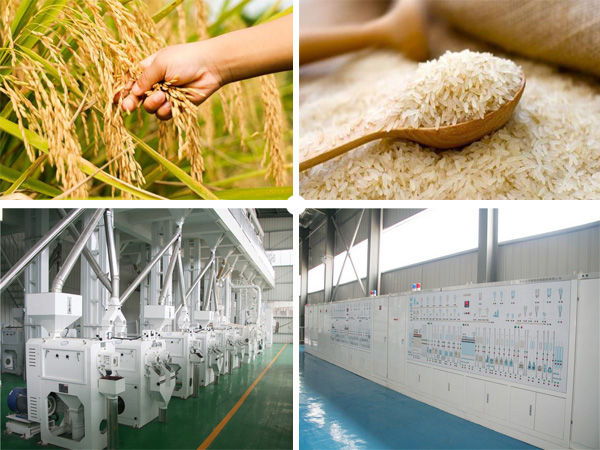 Rice milling plant
Rice milling plant
The modern rice milling process in large commercial mills combines a number of operations that produce better quality and higher yield of white rice from paddy or rough rice.
Below we mainly introduce the full details of modern rice milling process.
1. Pre-cleaning
When paddy comes into the mill, it contains foreign materials such as straw, weed seeds, soil, and other inert materials. If these are not removed before hulling, the efficiency of the huller and milling recovery will be large reduced. The capacity of the paddy pre-cleaner is normally 1.5 times the milling capacity. This is also the basic requimement during the modern rice milling process.
2. Dehusking
Paddy grain after precleaning. Poor quality grain is evident from its darker color. These are immature kernels or half filled grains that are not removed in the precleaner. The presence of poor quality grain lowers the total milling recovery. Brown rice is produced by removing the husk from rough paddy rice. The husk is removed by friction as the paddy grains pass between two abrasive surfaces that move at different speeds. After dehusking in modern rice milling process, the husk is removed by suction and transported to a storage dump outside the mill. Husk accounts for 20% of the paddy weight and an efficient husker should remove 90% of the husk in a single pass.
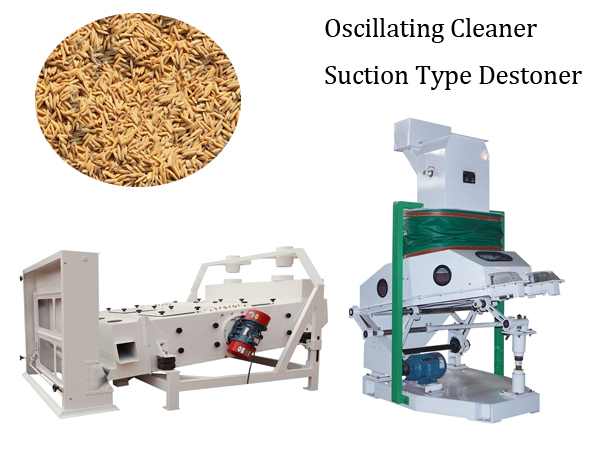 Rice pre-cleaning machine
Rice pre-cleaning machine
3. Paddy separation
The paddy separator separates unhusked paddy rice from brown rice. The amount of paddy present depends on the efficiency of the husker and should not be more than 10%. Paddy separators work by making use of the differences in specific gravity, buoyancy, and size between paddy and brown rice.This is key machine during the modern rice milling process.
4. Polishing the rice
White rice is produced by removing the bran layer and the germ from the paddy. The bran layer is removed from the kernel through either abrasive or friction polishers. The amount of bran removed is normally between 8% & 10% of the total paddy weight. To reduce the number of broken grains during the whitening process, rice is normally passed through two to four whitening machines connected in series.
Milled rice after the 2nd stage friction polisher. Small broken grains are still evident. This product goes to a sifter to remove the small broken grains during modern rice milling process.
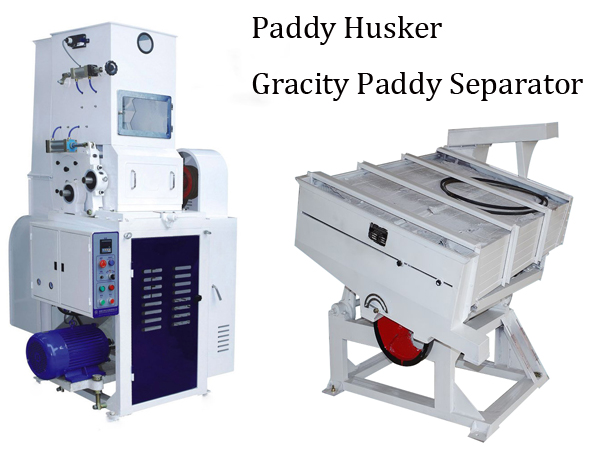 Rice husking and separating machine
Rice husking and separating machine
5. Separation of white rice
After polishing, white rice is separated into head rice, large and small broken rice, and “brewers” by an oscillating screen sifter. Head rice is normally classified as kernels that are 75-80% or more of a whole kernel. To attain a higher degree of precision for grading and separation a length or indent grader is used in modern rice milling process.
6. Rice mixing
A good rice mill will produce 50-60% head rice (whole kernels), 5-10% large broken and 10-15% small broken kernels. Depending on country standards, rice grades in the market will contain from 5-25% broken kernels. If rice mixing is to be done properly, then a volumetric mixer is necessary in modern rice milling process.
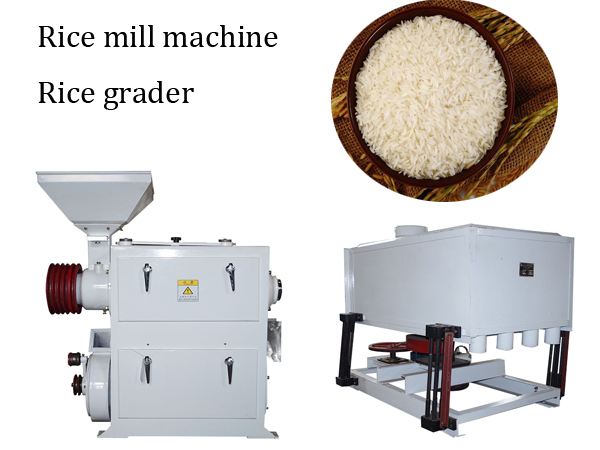 Rice milling machine
Rice milling machine
7. Mist polishing
Mixing a fine mist of water with the dust retained on the whitened rice improves the luster of rice (polishes) without significantly reducing milling yield. A friction type of whitening machine, which delivers a fine mist of water during the final whitening process, is used for “final” polishing before sale in modern rice milling process.
8. Color Sorting
Colo sorting is the last step during the modern rice milling process.
Advanced color sorters using technology and lighting to remove impure grains from the input on the basis of their color, rather than on the basis of their length or weight. Color sorting machines are equipped with several features such as auto sorting control systems, image capturing systems capable of storing up to 200 profiles to enable our customers to alter settings to suit their specifications, and a quality ejector system to monitor the quality of the output. The usage of anodized chutes for the passage of input grains prevents the blockage of the system, ensuring the smooth flow of grain
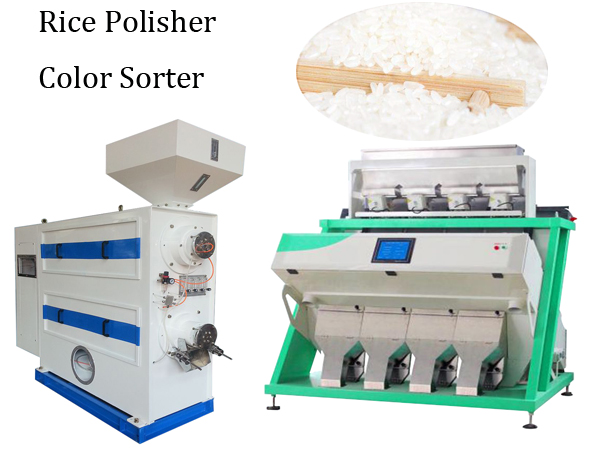 Rice milling machine
Rice milling machine
9. Packaging
Lastly, sorted rice will be packed directly.
In modern rice milling process , many adjustments (e.g. rubber roll clearance, separator bed inclination, feed rates) are automated for maximum efficiency and ease of operation. The whitener-polishers are provided with gauges that sense the current load on the motor drives which gives an indication of the operating pressure on the grain. This provides a more objective means of setting milling pressures on the grain.
-
 Investing in Cassava Starch Processing? Start with the Key Equipment for Success in Vietnam/Thailand Markets
Investing in Cassava Starch Processing? Start with the Key Equipment for Success in Vietnam/Thailand Markets
-
 The Potato Starch Processing Opportunity in 2025: Benefits and Challenges
The Potato Starch Processing Opportunity in 2025: Benefits and Challenges
-
 How to Choose Cassava Starch Processing Machine with Limited Capital to Cater for Both Farmers and Market?
How to Choose Cassava Starch Processing Machine with Limited Capital to Cater for Both Farmers and Market?
-
 Sustainable & Eco-Friendly Cassava Processing Solutions
Sustainable & Eco-Friendly Cassava Processing Solutions
-
 Solving 5 Common Challenges in Garri Processing with Modern Machinery
Solving 5 Common Challenges in Garri Processing with Modern Machinery
-
 Advantages of Cassava Starch Separating Machine - Centrifuge Sieve
Advantages of Cassava Starch Separating Machine - Centrifuge Sieve
-
 What is the capacity of cassava slicer manufactured by Henan Jinrui?
What is the capacity of cassava slicer manufactured by Henan Jinrui?
-
 How Much is the Cassava Agro Processing Machine Used for Cassava Flour Production?
How Much is the Cassava Agro Processing Machine Used for Cassava Flour Production?
-
 Which state in Nigeria produce the most cassava?
Which state in Nigeria produce the most cassava?
-
 Ghana kokonte flour processing facility layout and prices
Ghana kokonte flour processing facility layout and prices
-
 Henan Jinrui delivers attieke processing equipment to the customer in Côte d'Ivoire
Henan Jinrui delivers attieke processing equipment to the customer in Côte d'Ivoire
-
 Henan Jinrui Successfully Ships Cassava Flour Processing Line to Madagascar Client
Henan Jinrui Successfully Ships Cassava Flour Processing Line to Madagascar Client
-
 Henan Jinrui Advanced Cassava Starch Processing Equipment Wins Over Nigerian Food Processor
Henan Jinrui Advanced Cassava Starch Processing Equipment Wins Over Nigerian Food Processor
-
 Henan Jinrui Delivers Custom 1TPD Garri & Attieke Making Equipment to Benin
Henan Jinrui Delivers Custom 1TPD Garri & Attieke Making Equipment to Benin
-
 Henan Jinrui Secures Order from Benin for 1-Ton Daily Garri and Attieke Processing Machines
Henan Jinrui Secures Order from Benin for 1-Ton Daily Garri and Attieke Processing Machines
CONTACT US
DOING company offers cassava processing machine from single machine to the complete production line. If you want to get more details about cassava processing machine, please contact us:
- Do you want to buy machine?
- Yes, I want to buy machine
- No, I want to learn more in advance.
- What is your raw material?
- Cassava
- Potato
- Sweet potato
- Others
- 2. What is the final product you want to produce?
- Garri
- Cassava flour
- Cassava starch
- Cassava chips
- Attiekie
- Bammy
- Others
- 3.What is your capacity plan?
- Small scale garri machine
- 1ton per day
- 2tons per day
- 3tons per day
- 10tons per day
- 20tons per day
- Others
- 3.What is your capacity plan?
- Small scale
- 5tons per day
- 10tons per day
- 20tons per day
- 50tons per day
- 100tons per day
- Others
- 3.What is your capacity plan?
- Small scale
- 5tons per day
- 10tons per day
- 20tons per day
- 50tons per day
- 100tons per day
- 200tons per day
- 300tons per day
- Others
- 3.What is your capacity plan?
- Small scale
- Middle type
- Large scale
- What is your capacity plan?
- Small scale
- 5tons per day
- 10tons per day
- 20tons per day
- 50tons per day
- 100tons per day
- 200tons per day
- 300tons per day
- Others








